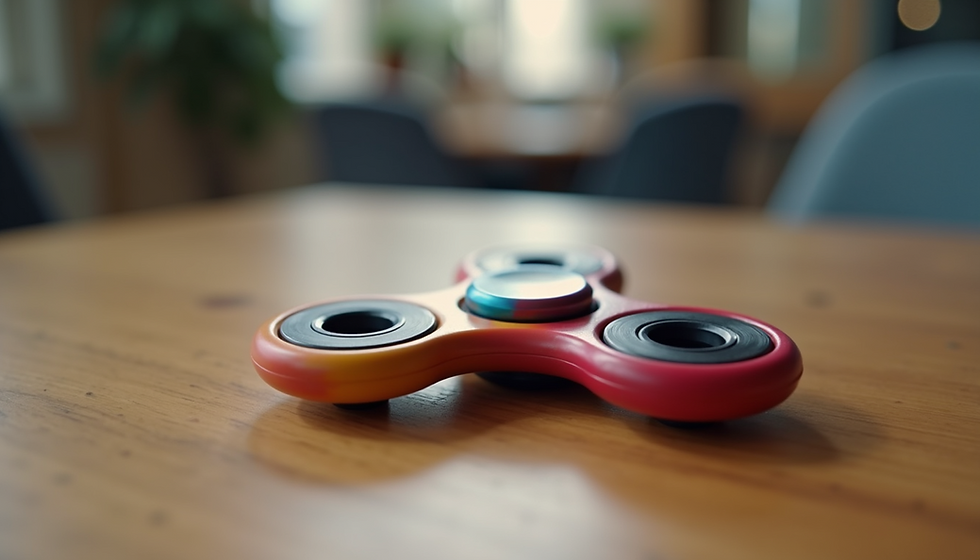Discover Effective Stress Relief Toys
- sensoryhaven4kids
- Aug 25, 2025
- 4 min read
In the gentle rhythm of daily life, moments of tension can quietly build up, especially for children navigating sensory challenges. Finding simple, effective ways to ease that tension can make a world of difference. One of the most heartening discoveries we have made in our work with children is the power of stress-relieving sensory tools. These thoughtfully designed items offer a comforting outlet, helping to soothe restless minds and bodies with ease and grace.
Exploring Stress-Relieving Sensory Tools: What They Are and How They Help
Stress-relieving sensory tools come in many shapes and sizes, each crafted to engage the senses in a calming, focused way. These tools are not just toys; they are bridges to tranquility, offering tactile, visual, or auditory stimulation that can help regulate emotions and improve concentration.
Some popular types include:
Fidget spinners and cubes: Small, handheld devices that provide repetitive motion to help focus restless energy.
Squishy balls and putty: Soft, malleable items that invite squeezing and stretching, releasing tension through touch.
Textured chewables and necklaces: Safe, sensory-friendly options for oral stimulation.
Weighted blankets and lap pads: Providing gentle pressure that can calm the nervous system.
Visual sensory toys: Such as liquid timers or light-up gadgets that captivate with soothing movement and colors.
Each tool offers a unique sensory experience, and the best choice depends on the individual’s preferences and needs. For example, a child who finds comfort in tactile input might benefit from a soft, squeezable toy, while another who is visually oriented might find peace watching a liquid timer flow.

Sensory Haven Offers a Variety Of Fidget Bags Containing Popular Fidget Tools.
How to Choose the Right Stress-Relieving Sensory Tools
Selecting the perfect sensory tool can feel overwhelming, but focusing on a few key factors can guide the way:
Identify sensory preferences: Observe which senses your child responds to most positively. Do they enjoy touch, sight, or sound?
Consider the environment: Some tools are better suited for quiet spaces, while others can be used discreetly in classrooms or on the go.
Safety first: Ensure the materials are non-toxic, durable, and appropriate for the child’s age.
Ease of use: Choose items that are simple to operate and maintain, encouraging consistent use.
Portability: Smaller, lightweight tools are great for carrying in backpacks or pockets.
Trying a few different options can be a wonderful way to discover what truly resonates. Many families find that having a small collection of sensory tools allows for flexibility depending on the situation.

Do Anti-Stress Toys Work?
This question often comes up, and from our experience, the answer is a heartfelt yes. Anti-stress toys can be incredibly effective when used thoughtfully. They work by providing a controlled sensory input that helps the brain regulate emotions and reduce feelings of anxiety or overwhelm.
Scientific studies support the benefits of sensory engagement for calming the nervous system. For example, repetitive motions like spinning or squeezing can trigger the release of endorphins, the body’s natural mood enhancers. Weighted items apply deep pressure stimulation, which has been shown to promote relaxation and improve focus.
However, it’s important to remember that these tools are part of a broader approach. They work best when combined with supportive routines, understanding, and sometimes professional guidance. The key is consistency and patience, allowing the child to explore and find comfort in these sensory experiences.
Practical Tips for Integrating Stress-Relieving Sensory Tools into Daily Life
Incorporating sensory tools into everyday routines can create a nurturing environment that supports emotional well-being. Here are some gentle suggestions to help make this integration smooth and effective:
Create a sensory-friendly space: Dedicate a small area at home or school where your child can retreat to use their tools when feeling overwhelmed.
Use tools proactively: Introduce sensory toys during transitions or before potentially stressful events to help prevent anxiety.
Encourage self-awareness: Teach children to recognize their feelings and reach for their sensory tools as a positive coping strategy.
Model calm behavior: Show how you use similar techniques to manage your own stress, reinforcing the value of these tools.
Keep tools accessible: Store them in easy-to-reach places so they can be used spontaneously when needed.
By weaving these tools into daily life, they become trusted companions on the journey toward calm and focus.

Embracing the Journey with Sensory Tools
Finding the right sensory tools is a personal and evolving journey. Each child’s needs and preferences are unique, and the beauty lies in discovering what brings them comfort and joy. Whether it’s the gentle squeeze of a soft ball or the mesmerizing flow of a liquid timer, these tools offer more than just distraction - they provide a pathway to calm, confidence, and connection.
If you’re looking to explore a carefully curated selection of stress relief toys designed with care and expertise, Sensory Haven 4 Kids offers a wonderful range tailored to support children with sensory processing differences. Their commitment to quality and understanding shines through our products, making it easier to find the perfect fit for your family.
Remember, every small step toward calm is a victory worth celebrating. With patience, love, and the right tools, calmer days are always within reach.













Comments